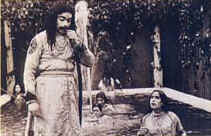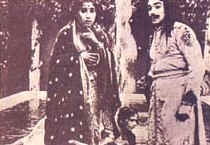Salunke - Actor - 1912 - 1928
 [1]from phalke's journey
[1]from phalke's journey
Phalke looks for a subject for his first feature film, and decides to make ‘Raja Harischandra’.
'beauty has been my obsession for the last thirty years, every since I took to visual arts like painting, drawing, photography, theatre and cinema.
Although my art is flawless scientifically, yet, to create on the screen a faultless visual image of a physically defective actor is beyond my power.
Photography reveals what exists in reality, and artificial devices like retouching cannot be done in photography.
This is because the picture is very small i.e. ¾ of an inch, and the faces on it are often smaller than a pulse grain. If one would keep a pencil on it, every point of the pencil mark will be enlarged on the screen. The face will thus come on the screen as though pierced with nails.
So I advertised. ‘Wanted, fair looking actors’
To my surprise, most of the applicants flocking to my door were ignorant even of the meaning of the word ‘good looking’.
The very next day, a man came to me with this new advertisement in his hand. His normal complexion was very dark, which could at best be improved to bluish after soaping the face. And this blue-black person told me he had enacted the role of Mahashveta, the lady in white, in ‘Shapa Shambhrama’ for a famous company!
After two hours descended another gem of an actor.
He gave an impression of looking at the boxes in the inner room while he was talking face to face with me of his experience of acting. In a afternoon, a man with a 40-inch waistline came to claim the role of Taramati in my ‘Harischandra’. As if this person, who looked like a woman in the advanced stages of pregnancy, or even as a walking advertisement for some health tonic, was the power actor to portray the character of Taramati, an unfortunate, dejected and resigned person.
They were an ugly lot, with gloomy faces, visible protruding teeth, with malformed eyes and noses, with hollow cheeks scarred with pox i.e. faces which were created by the god Brahma at the end of the working day, when he had run out of material.
O India, what a terrible state you are in!
Sometimes, some candidates used typical womanish expressions as refrains while describing their acting experience, in order to prove that they had been portraying female characters. I was even scared that one of them would put his arms around me in embrace!
I was very surprised to see that the changed advertisement did not bring any different kinds of applicants.
The truth dawned on me when I looked at a mirror in a betel leaf shop. Any man chewing betel leaf in front of a shop would look at the shop mirror and indulge in a play of his eyes Only when he is convinced, after seeing from all angles, that there is not the slightest flaw in his total appearance will he move off with a smile of content.
In India herself, there will be 30 x 2 crore mirrors. But how many faces will there be which can really grace these mirrors, and how many of these are likely to come to my films?
A person may appear beautiful simply because we like that person or love him. We may have a sensation of happiness because we are in a mood of love or joy or intimacy or youthful exuberance. This sensation of happiness is quite different from the happiness derived from looking at a person with a beautiful, healthy form.
Even the women of the red-light areas are reluctant to work in the film.
Finally one day, in a restaurant at Grant Road, he notices a young man at work, Salunke, a cook with delicate features and slender hands.
Phalke asks him how much is making as a cook. ‘Five rupees a month’, Salunke replies. ‘I will give you fifteen to act in my film.’
So Salunke is hired to play the role of Taramati in ‘Raja Harischandra’.[[2]]
There was total dearth of artistes willing to work for films, because of the peculiar stigma attached to filmmaking. Phalke’s advertisements in Bombay’s Induprakash towards May 1912 viz. ‘Handsome faces wanted for films’ drew only third – rate stage artistes. So much so that he had to add one more line in the subsequent advertisement ‘ugly faces need not apply!” But the toughest job was that of finding suitable female artistes. An expert cameraman, Phalke was convinced that female roles must be played by females to meet the exacting demands of the camera. “ I used to get replies occasionally to my advertisement from such (Red-light) areas as phanaswadi; Akkalkot Lane, Hanuman Lane, Kennedy Bridges etc.; from prospective female artistes and I never lost a single opportunity to meet the applicants” writes Phalke in hi autobiography. But on some cause or the other, all these applicants withdrew later. With great difficulty, Phalke had brought a female artiste for a scene in Raja Harischandra But Phalke regrets that “after coaching her four days, her sheth whisked her away.” Phalke, therefore, had no alternative but no train suitable male actors to play female roles – a practice in vogue on stage, then.
The production problems were many and varied because of total ignorance about the art and technique of filmmaking. “I had to do every-thing”. Phlake told the film Inquiry Committee on February 13,1928. “I had to teach acting. I had to writ the scenario, do the photography and the actual projection too. Nobody knew anything in India about the industry in 1911. Phalke turned raw hands into film acting, fixed up a studio Dadar Main Road, Bombay, where he had stayed formerly for about seven years, in the bungalow of Maturates Manji Walji; wrote the story and scenario of truthful Raja Harischandra; prepared suitable drapery; erected the sets and started the actual work of shooting presumably after the rainy season of 1912, The title role of Raja Harishchandra was played by Dabke and that of Taramati by Saulunke, while Rohidas was played by Phalke’s own son – Bhalchandra.
The Sacred and the Profane
The bathtub sequence, when Harischandra enters the frame to beckon his wife Taramati, seen in the company of her fully drenched attendants, a couple of whom are fiddling with the sprouting fountain located at the centre, is indeed the first bathtub scene in Indian Cinema. The extent of sensuousness which Phalke has managed to infuse into this well designed scene can be gauged, when we realize that all the females in their wet sarees, clinging to their bodies are in fact, all males in female garb! Only a fertile mind as that of Phalke could have gauged the need for incorporating an erotic scene in what is basically a "religious" subject. [3]
